|
|
don't think twice
BOB DYLAN THE PAINTER

by
ANDREW GRAHAM-DIXON
_______________________________________________
Andrew
Graham-Dixon
is
one of the leading art critics and presenters of arts television
in the English-speaking world. He has presented numerous landmark
series on art for the BBC, including the acclaimed A History
of British Art, Renaissance and Art of Eternity, as well as
numerous individual documentaries on art and artists. For more
than twenty years he has published a weekly column on art, first
in the Independent and, more recently, in the Sunday
Telegraph where this review initially appeared.
He has written a number of acclaimed books, on subjects ranging
from medieval painting and sculpture to the art of the present.
The
Italian Futurists believed modern art should embrace the modern
world, and cursed museums as the dead repositories of a dead
past. They dreamed of firebombing the Uffizi and of razing the
Louvre to the ground. Bob Dylan in the 1960s had his own doubts
about museums too, calling them “cemeteries.” He
believed “paintings should be on the walls of restaurants,
in dime stores, in gas stations, in men’s rooms. . .”
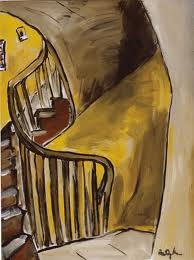 But
museums have a way of absorbing such attacks. They also have
a way of absorbing the work of their fiercest critics as well.
Most of the paintings of the Futurists have ended up in museums.
The manuscripts of Dylan’s own song lyrics will no doubt
wind up there too, and the same fate probably awaits Dylan’s
hitherto little known work as a draughtsman and painter. The
best of it is forthright, sincere, immediate and surprisingly
accomplished. It has the added appeal of being a kind of diary,
kept in images, by one of the most celebrated songwriters and
musicians of modern times. It has already been shown once in
a museum – the Kunstsammlungen Chemnitz Museum, in Germany,
to be precise, which staged the first serious exhibition of
Dylan’s work as a fine artist in the winter of 2007. But
museums have a way of absorbing such attacks. They also have
a way of absorbing the work of their fiercest critics as well.
Most of the paintings of the Futurists have ended up in museums.
The manuscripts of Dylan’s own song lyrics will no doubt
wind up there too, and the same fate probably awaits Dylan’s
hitherto little known work as a draughtsman and painter. The
best of it is forthright, sincere, immediate and surprisingly
accomplished. It has the added appeal of being a kind of diary,
kept in images, by one of the most celebrated songwriters and
musicians of modern times. It has already been shown once in
a museum – the Kunstsammlungen Chemnitz Museum, in Germany,
to be precise, which staged the first serious exhibition of
Dylan’s work as a fine artist in the winter of 2007.
Yet
the essence of Dylan’s The Drawn Blank Series
is its spirit of resistance to a certain idea of the museum
and what it represents – the idea of becoming, oneself,
a kind of institution, fixed and frozen by illusions of self-importance.
These pictures are the work of someone famous who is emphatically
not buying into his own mummification as genius or guru. That
is implicit in their sheer matter-of-factness, their informality,
their glancing encounters with the stuff of everyday existence.
They are grounded in the ordinary and the mundane and might
almost have been created by the artist in order to remind himself
that, no matter what anyone says, he is (as the Tammy Wynette
song goes) just a man.
There
is also a shyness, or a profound aloofness – hard to say
which – in the type of looking that made these images.
The Dylan look, characteristically, does not seek eye-to-eye
contact. It is directed restlessly away or sideways, to dwell
on the ordinary things anyone might absent-mindedly fix on –
an arrangement of chairs by a motel pool, a family restaurant
seen from across a street, a house on the top of a hill. 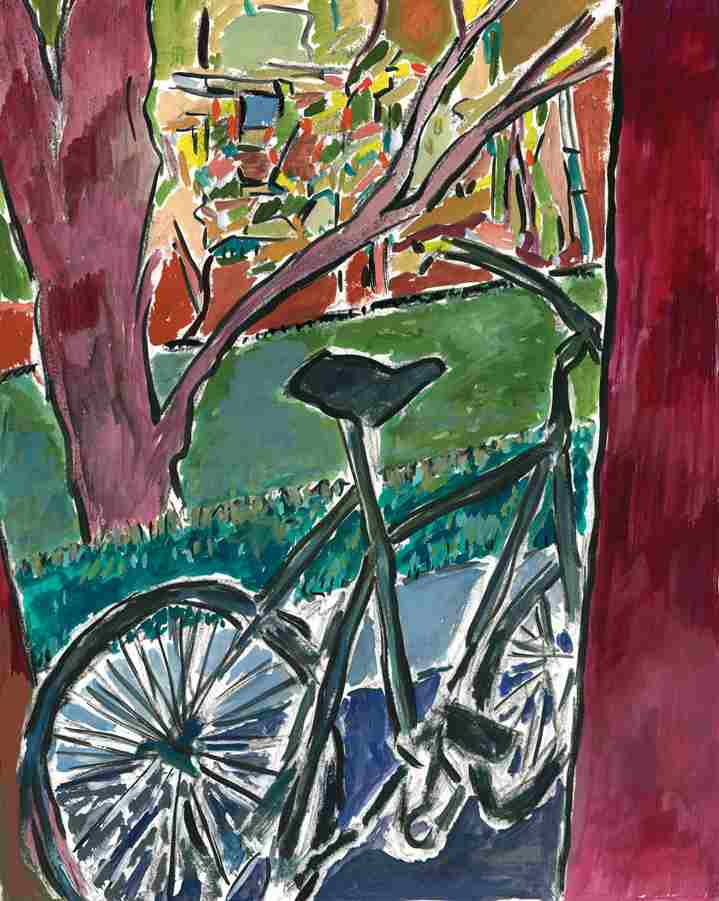 The
ordinariness is much of the point. Dylan draws and paints as
if no one has noticed him. One dream that his pictures might
embody is that of being disregarded. The
ordinariness is much of the point. Dylan draws and paints as
if no one has noticed him. One dream that his pictures might
embody is that of being disregarded.
There
is also an undeniable melancholy about many of the pictures
in The Drawn Blank Series, a sense of rootlessness
and transience. This may have something to do with their origins,
which are a little complex. All of the images have been created
recently, since 2007, but they are without exception based on
templates which Dylan drew in the late 1980s and early 1990s.
During those years, he made a large number of drawings in spare
moments while touring the United States, Mexico, Europe and
Asia. To make The Drawn Blank Series, he had those
drawings scanned on to scaled-up sheets of paper and proceeded
to work them up in a variety of media, including pencil, watercolour
and gouache. Each might be compared to a fresh performance of
an old song; and the series continues to grow. Halcyon Gallery
has extended the number of works first shown at Chemnitz, to
incorporate another 75 originals made exclusively for the exhibition
that coincides with the publication of this book. In these new
pieces, Dylan explores further ways of working with the images.
But no matter how great the transformations of line and colour
in each one, the lineaments of the originals continue to set
the emotional register of the series as a whole.
They
record the disconnectedness of life on tour, a life lived out
of a suitcase, with every day punctuated by the abrupt rhythms
of upheaval from one place and adjustment to somewhere new.
The artist sees boats dancing on the water, beyond the balcony
of his hotel room. He visits the hallway of a baronial castle.
He eats a meal in the restaurant car of a train. He looks down
at a back alley in Chicago. He looks across the street at a
family restaurant. There are no links between the different
things that he sees, except the fact of his seeing them.  One
day he gazes at the bulk of an ancient cathedral, which he paints
as a dark and heavy silhouette, forbiddingly monumental –
all the more so by contrast with the truncated glimpse of a
human leg, perhaps his own, that he includes in this cropped
and snapshot-like composition. The contrast between the solidity
and stability of the church and the artist’s own footloose
existence is implicit. One
day he gazes at the bulk of an ancient cathedral, which he paints
as a dark and heavy silhouette, forbiddingly monumental –
all the more so by contrast with the truncated glimpse of a
human leg, perhaps his own, that he includes in this cropped
and snapshot-like composition. The contrast between the solidity
and stability of the church and the artist’s own footloose
existence is implicit.
The
sequence of pictures includes portraits of people met on the
way – a driver, a pair of sisters, a sturdy woman seen
from the back in an English pub called The Red Lion, a half
naked girl in a room – but there is rarely the sense of
any strong and deep affinity between the artist and his sitters.
Their faces are often mask-like and impassive (although in the
case of one or two portraits of women there is light in the
eyes, and a flicker of affection can be felt). The artist seems
to reserve his truest feelings of identification for unpeopled
views and inanimate objects. His pictures of railroad tracks
seem particularly charged with romantic feeling. The dynamic
perspective of these images, together with their varyingly dramatic
skies, evoke the sense of picaresque adventure long associated
with travel through the wide open spaces of America. The railway
paintings are like pictures of the feelings embodied in the
itinerant folk songwriting traditions of the United States –
the tradition of Woody Guthrie, among others – to which
Dylan has always felt close.
Objects
associated with travelling, with staying on the move, clearly
appeal to him. An old bicycle, propped just so, detains his
attention for quite some while. It fits his eye. He draws it
as if it were the poignant skeleton of an animal encountered
on a country walk.
He
also dwells with particular sympathy on the rickety panels and
bent stovepipe exhaust of an old truck, parked at some kerbside
or other with no one behind the wheel. He revisits the image
several times, colouring it in different ways, enhancing the
beaten-up quality of the bodywork and the uneven layers of retouched
paint. 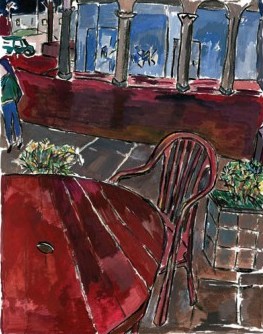 These
apparitions of a much-travelled vehicle, battered by its passage
through life but still dauntless, prompt the vague suspicion
that these might be disguised self-portraits, of a kind. These
apparitions of a much-travelled vehicle, battered by its passage
through life but still dauntless, prompt the vague suspicion
that these might be disguised self-portraits, of a kind.
Dylan’s
work as draughtsman and painter is unlike that produced by most
occasional artists because it has such a strong look of authenticity.
It is engaging precisely because it is not the fruit of some
misguidedly self-conscious attempt to live up to some ideal
of art. In fact it is a hallmark of his creative activity that
pretty much everything he does to express himself – painting,
writing, singing, presenting a radio show – feels of a
piece with everything else. That is not to say that his pictures
are on the same level as his music. But they are true to their
creator’s sensibility, uncompromised by sentimentality
or ambition – which is why they amount to considerably
more than celebrity memorabilia, the modern equivalent of a
saint’s relics.
There
is plainly no great divide between Dylan the writer and Dylan
the creator of visual images. Chronicles, the first
volume of his autobiography, is a compellingly visual book.
Its prose frequently takes the form of sequences of word paintings,
and Dylan writes in general with an uncanny sense of apparently
total visual recall.
Describing
New York, in the first winter that he spent there, he compiles
a brusque, staccato anthology of quickfire images, each one
like a picture etched in the memory:
Across the way a guy in a leather jacket scooped frost off the
windshield of a snow-packed black Mercury Montclair. Behind
him, a priest in a purple cloak was slipping through the courtyard
of the church on his way to perform some sacred duty. Nearby,
a bareheaded woman in boots tried to manage a laundry bag up
the street. There were a million stories . . . ”
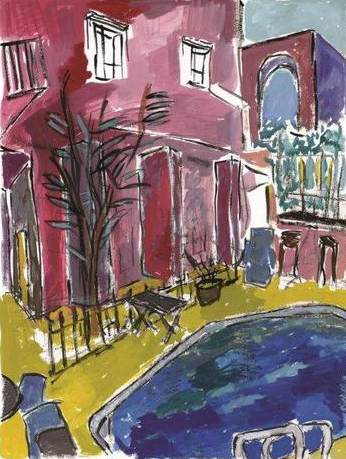 Elsewhere,
remembering his friend Ray’s New York apartment, where
he would sometimes stay, he can summon up the image of a particular
piece of furniture in virtually photographic detail: Elsewhere,
remembering his friend Ray’s New York apartment, where
he would sometimes stay, he can summon up the image of a particular
piece of furniture in virtually photographic detail:
There were about five or six rooms in the apartment. In one
of them was this magnificent rolltop desk, sturdy looking, almost
indestructible – oak wood with secret drawers and a double
sided clock on the mantel, carved nymphs and a medallion of
Minerva – mechanical devices to release hidden drawers,
upper side panels and gilt bronze mounts emblematic of mathematics
and astronomy.
Dylan’s
paintings demonstrate the same strong sense of detail, the same
strong interest in the mood and the specifics of a place as
his prose – and indeed his lyrics, which often turn on
the vivid memory of an unusual object (such as, say, a leopardskin
pillbox hat). The difference is that so many of the things that
he paints and draws in The Drawn Blank Series have
a singularly disenchanted aura about them, a feel of unresisting
and unrewarding blankness – the bland sixties chest-of-drawers
in “Carbondale Motel,” or the switched-off television
set in the shuttered interior of “Lakeside Cabin,”
with its distinctive, old-fashioned, potbellied screen of thick
glass (to give just two of a hundred examples). It is hard,
albeit not entirely impossible, to imagine such objects being
transmuted into the stuff of poetry or song. One of the paradoxes
of Dylan’s art is the fact that while it squarely addresses
the world of everyday things and experiences it also speaks
of reticence and even reclusiveness.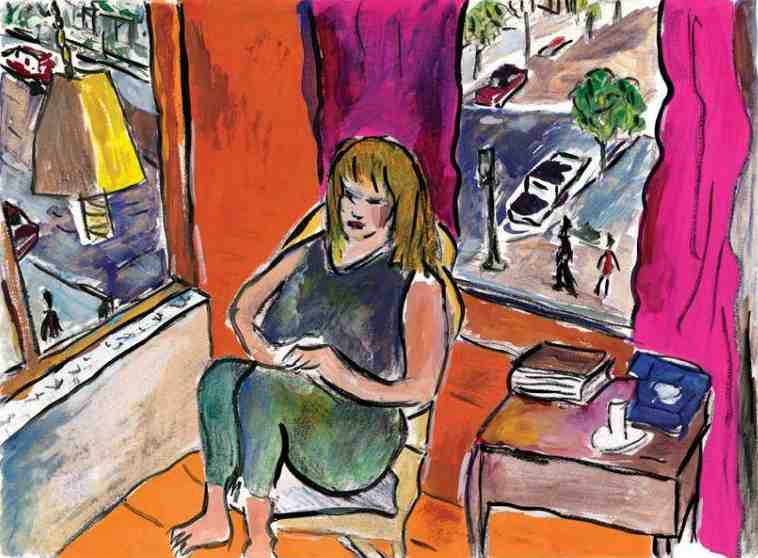 It is an art that seems, frequently, to confess its creator’s
inability to engage with the world, for much of the time, at
a more than superficial level. That is the sadness at its centre.
It is an art that seems, frequently, to confess its creator’s
inability to engage with the world, for much of the time, at
a more than superficial level. That is the sadness at its centre.
Dylan
has said that his favourite artists are Donatello, Caravaggio
and Titian – a red-blooded triumvirate, united by their
depth of feeling for life and their virtuoso ability to conjure
illusions of physical and emotional reality. But his actual
style and sensibility seem far closer to the art of late nineteenth-century
France than that of Renaissance Italy. His coiled and slightly
nervous manner of drawing, which often teeters on the brink
of the cartoon or caricature, is in a line of descent that goes
back to the work of artists such as Toulouse-Lautrec, Degas
and Van Gogh – all of whom deliberately played, themselves,
on the borders between the caricature or cartoon and the work
of fine art. In fact, Dylan’s “Man on a Bridge”
might almost be a pastiche of a Van Gogh drawing; the figure
even has something of a Van Gogh look about him.
It
is not particularly surprising that Dylan’s art should
have its most obvious debts there. The Parisian painters of
the late nineteenth century were inspired by a particular ideal
of modern, urban realism that was to have an enormous influence
on the whole world of the arts – music, dance, literature,
poetry and music, as well as painting. Their ambition to be
“painters of modern life,” to catch the teeming
and multitudinous spirit of “modernity” itself,
to celebrate the lives of whores and courtesans and dockworkers
as well as the lives of the careless rich, would reverberate
through the culture of the twentieth century. An American painter
such as Edward Hopper was heir to the ideals of realism forged
in the aesthetic workshop of nineteenth-century 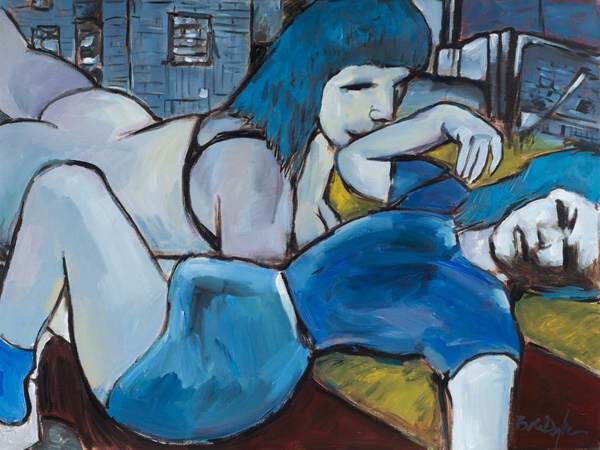 Paris.
The same holds true for an author such as Jack Kerouac, whose
On the Road applies the principles of modernist realism
to the theme of an American odyssey. And it holds true too –
in spades – for the young Bob Dylan, songwriter and poet-musician
of the multiplicity of lives around him. So it makes perfect
sense that, as a painter and draughtsman, he should hark back
to the early modernist tradition that was always a kind of spiritual
home for him in the first place. But it also needs to be said
that what is going on, in The Drawn Blank Series, is
a little more complicated than just a harking back. Paris.
The same holds true for an author such as Jack Kerouac, whose
On the Road applies the principles of modernist realism
to the theme of an American odyssey. And it holds true too –
in spades – for the young Bob Dylan, songwriter and poet-musician
of the multiplicity of lives around him. So it makes perfect
sense that, as a painter and draughtsman, he should hark back
to the early modernist tradition that was always a kind of spiritual
home for him in the first place. But it also needs to be said
that what is going on, in The Drawn Blank Series, is
a little more complicated than just a harking back.
The
aesthetic ideals of classic early modernism were most eloquently
enshrined in Charles Baudelaire’s essay, “The Painter
of Modern Life.” In a celebrated, virtuoso passage of
writing, Baudelaire personifies the ideal modern artist’s
creative and open approach to the chaos of modern life in the
figure of the flaneur – one who wanders the city’s
streets and boulevards, immersing himself in the sights and
sounds and above all the infinitude of lives that surround him
there:
The crowd is his element, as the air is that of birds and water
of fishes. His passion and his profession are to become one
flesh with the crowd. For the perfect flaneur, for
the passionate spectator, it is an immense joy to set up house
in the heart of the multitude, amid the ebb and flow of movement,
in the midst of the fugitive and the infinite. To be away from
home and yet to feel oneself everywhere at home; to see the
world, to be at the centre of the world, and yet to remain hidden
from the world – such are a few of the slightest pleasures
of those independent, passionate, impartial natures which the
tongue can but clumsily define. The spectator is a prince who
everywhere rejoices in his incognito... Thus the lover of universal
life enters into the crowd as though it were an immense reservoir
of electrical energy. Or we might liken him to a mirror as vast
as as the crowd itself; or to a kaleidoscope gifted with consciousness,
responding to each one of its movements and reproducing the
multiplicity of life and the flickering grace of all the elements
of life. He is an ‘I’ with an insatiable appetite
for the ‘non-I’, at every instant rendering it and
explaining it in pictures more living than life itself . . .
”
Change
the word “pictures” to “songs,” in that
last sentence, and you have a near-perfect description of the
young Bob Dylan as songwriter – his sensibility, his methodology,
his kaleidoscopic (and ventriloquistic) gift of reflection.
Dylan’s own autobiography, Chronicles, is a nearly
uncanny confirmation of his Baudelairean heritage. It is a book
that recounts, on page after page, his picaresque progress through
life as a modern, American version of the flaneur,
a man immersed in the world but almost invisible to those around
him, gathering the materials for his art from the teeming lives
of the city – guys in leather coats, priests in purple
cloaks, women struggling with their laundry, “a million
stories” on all sides.
But
something happened to compromise Dylan’s sense of engagement
with the world, something that struck home to him in about the
mid-1980s – not long, in fact, before he did the drawings
that form the basis of The Drawn Blank Series. The
realization had been gradually dawning in him that his own celebrity
had cut him off from the very subject matter – raw and
actual life, in the immediacy of its unfolding – that
was the wellspring of his imagination. He described the process
in an interview rather grudgingly given to a documentary-maker
named Christopher Sykes, for a film transmitted in the BBC’s
Arena strand in the autumn of 1987. As Sykes attempted
to elicit answers from him, Dylan simply drew a portrait of
his would-be interviewer, refusing to respond with more than
a monosyllabic response. But in the end he opened up for a few
brief seconds. His theme was fame and why, for an artist such
as him, it was a kind of curse. “It’s like when
you look through a window – say you’re passing a
little pub or inn – and you see all the people eating
and drinking and carrying on. You can watch outside the window,
and you can see them all being very real with each other, as
real as they are going to be. Because when you walk into the
room, it’s over, you won’t see them being real any
more . . . ”
That
sense of being on the outside of life – a life that will
change and become artificial as soon as you walk in –
is everywhere in the images of The Drawn Blank Series.
It is there in the deliberate solitariness implied by so many
of the pictures, documenting as they do an existence spent holed
up in hotel rooms or other places of refuge. It is there in
their frequently unsettling, liminal perspectives – threshold
perspectives, which suggest the point of view of someone hovering
on the point of going into a place but never quite going through
with the intention. A house is seen from across the street,
a tenement building is viewed from the fire escape side, a street
is viewed, through the railings of a balcony, and from above.
One
writer responded to the first exhibition of pictures from The
Drawn Blank Series, at the Kunstsammlungen Chemnitz Museum
by remarking that nearly all of the paintings exhibit what in
German is known as schwellenangst – the fear
of entering a place. It was a perceptive comment. Dylan does
have a constant habit of framing images through doors or windows
or passageways, from the half-seclusion of balconies or verandas
– or to be strictly accurate that is what Dylan did, some
twenty years ago, when he originally composed these images,
which seem in so many ways like the visual expression of the
consuming melancholy so evident in his remarks about how he
felt, those days. The truth is that the pictures in The
Drawn Blank Series are palimpsests, or memories revisited
at a distance and altered in the process. In many cases he has
cheered up his original drawings in the act of reworking them
– adding little touches of humour or anecdotal detail,
or enlivening them with bright colour schemes that seem to evoke
the decorative compositions of an artist such as Raoul Dufy.
Dylan is no longer the melancholic that he was, back in the
1980s, when he began The Drawn Blank Series But in
the end there is no concealing the essential melancholy that
is written into almost every one of its compositions. These
pictures are the lament of a flaneur who can no longer
plunge into life in the way that he used to. They are the sad
song of a spectator-prince who has lost his incognito.
Note: Graphics added (and cropped from white background) to
original article.
Republished according to Creative
Commons Act.
|
|
|